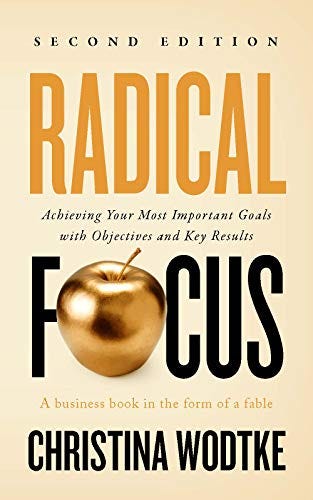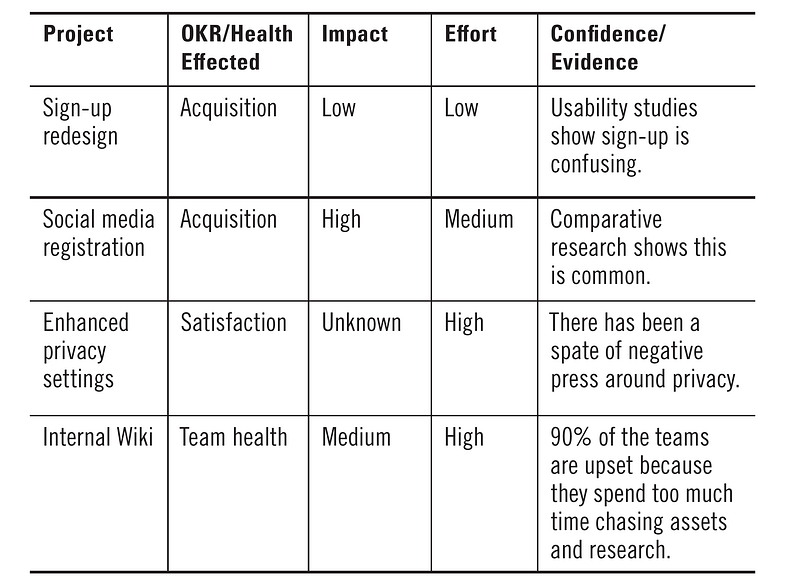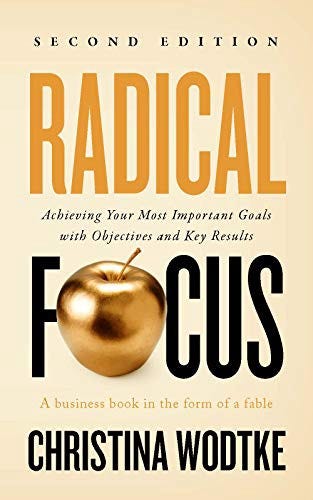There is a concept I call drift. Drift means that a process has drifted away from the original framing. It happened to Agile. What started as a simple idea that people should work collaboratively and iteratively became people policing each other on the True Agile Way: “this is how to write a user story” and “Stand up can’t be more than 15 minutes long.”
A vision of a better way to work became a cargo cult. If we just follow the steps perfectly, we will be as big as <insert wildly successful company that uses Agile here.>
Once people were told what to do but not why to do it, the practice of Agile got watered down. “We’re Agile but the stakeholders feel more comfortable with a roadmap. And we need to write down requirements because our programmers in India and the Balkans are in different time zones. But we still do stand-up!”
Thus goes OKRs.

When I wrote Radical Focus, I was almost the only one promoting OKRs. There was no special software, nearly no consultants¹ to help. That’s changed.
Now we see new articles every day on OKRs and the advice is all over the place. “Sure, key results can be deliverables” “Everyone should have OKRs,” “Weekly OKRs are fine,” “Cascading is you take your boss’ Key Result and make it your Objective” (I really hate this one.) I do think that the OKR practice needs to adjusted to different cultures, but trying to shove the OKR process into a dysfunctional org is like Cinderella’s sisters cutting off toes to fit into the glass slippers. It hurts and it doesn’t fool anyone.
Let’s start with the basics.
The objective is qualitative and aspirational and key results are measurable signs the objective has been met. You want qualitative and quantitative goals in order to inspire people who are motivated by vision and people who are motivated by numbers. No, Making 20 million dollars can’t be your OKR. No, your boss’ key result can’t be your objective. That defeats the point.
The quarter is the most useful unit to run OKRs, followed by annual OKRs for more mature companies. A quarter is just long enough to make progress and not so long you’ve forgotten what you were trying to do. It matches business’s cycles and it’s quite easy to end a quarter with a retrospective. An annual OKR set helps inspire an organization by making a vision concrete.³
Key Results need to be outcomes, not outputs. If you make a key result “launch this feature” and halfway through the quarter you discover it won’t move the number you hoped it would, you’re stuck. You committed to that feature and now you feel like you have to deliver it. But if you pick a number you want to move, you can try dozens of things to change it.
Have one OKR set for small businesses and one OKR set per business model for larger ones. To this, people often say to me “How do we do everything else?” to which I usually answer, “How are you doing it now?”

Life is very full of shiny objects. There is competitive research and tracking metrics and product management and project management and backlogs and burndowns and more.
Different companies have different ways of getting things done. OKRs should sit lightly to top of all your other initiatives, projects, expansions and activities. You set an Objective so that people do not forget to work on what is important strategically but not urgent. You add Key Results to quantify success. You manage it with the monday commitments and friday celebrations to make sure all that other stuff doesn’t result in everyone forgetting about the important but not urgent.
You can commit to other things and celebrate other things as well, but you want to remind people: this goal is important to us!
Commit and Celebrate every week. Do a retrospective every quarter. OKRs are more than a goal setting and achieving strategy; they are also a learning strategy. If you discuss your goal twice a week and go over what is working and what is not working, by the end of the quarter your team is a lot smarter about that goal. Then at the end of the quarter, you stop and review and share all that learning. The next quarter you do it again. And over years, your team become more capable and knowledgeable about your market and what it takes to succeed.
The best is the enemy of the good. If you are spending weeks refining the language of the objective and pinning down just the right metrics, your company is in the business of process management. That’s wasteful.
Try to make good OKRs but remember there is a time when you have to say, good enough for now. You don’t want to spend three weeks setting your goals and lose the time you could be working toward them instead.
Often people ask me, how do I know what key result to set? How do I know how much it should improve?
I say “Go ahead and guess.”
I read once a long time ago that predictions and estimates are a skill. You start by guessing, but as time goes one you develop an instinct. I have found that to be true. You don’t have to get your OKRs perfect because you are building an intuition, not because you’ll be held accountable for getting it “right.”
Give up roadmaps. If you want to be a nimble team, you want a pipeline instead (i.e. a prioritized validated backlog.) You want a list of good ideas for ways to achieve your goals (both OKRs and ordinary everyday needs.) This allows you to change tactics when circumstances shift.

Keep OKRs as simple as possible.
We have terrible working memory. If your OKR’s get complicated, long and multitudinous, you won’t get success. You’ll get people scrambling to achieve them in the last month and making a tiny bit of progress on half of them.
Don’t Put the Cart Before the Horse
I know everyone wants results yesterday, but that won’t lead to sustainable success.
Do the prework. Make sure you have a crisp strategy. Make sure your teams have psychological safety. Make sure your product teams are multidisciplinary (Product, Design and Engineering.) Fire bad managers. Adopt Agile and Lean practices. Create as many self-sufficient teams as possible. Value effectiveness over efficiency.
Ready to take on OKRs? Go slow. Start with a pilot with one of those self-sufficient teams. Let them figure out what will and won’t work. Then add a few more the next quarter. Have the execs set theirs and dogfood the process.
Do it the right⁴ way before you start editing the process.
If you’ve read about OKRs and the first thing you think is, we can’t do that because we’re remote/no one has control over their product/everyone is dependent on other teams/stakeholders need roadmaps STOP and work on those issues first.
If you don’t think those are issues, don’t try OKRs.
OKRs are like the advice “Eat less and exercise more.” They are simple and hard. If you’d rather rename what you are doing now without any changes to how you work, be my guest.
Just don’t call it “OKRs.”
Learn More
Using OKRs to Increase Organizational Learning
Why Key Results Need to Be Results
One Objective to Rule them All
Or just buy the book….

Notes
- I do consult occasionally, but my day gig is teaching at Stanford. And I love it! Ben started consulting around the same time as me, but maybe a little before?
- Contribution is not the same as “making your OKRs.” Did this person make smart choices and stay focused on moving the numbers? Did they gain traction? Did they learn what not to do?
And not everyone can contribute to OKRs, so you will need something more than “making OKRs” to evaluate them on. - This is less a rule than a guideline. Slow moving companies in research or medicine may not have any goals they can meet in three months. I have a way to deal with that also.
- Perhaps I should say, do it the Radical Focus way before editing. The methodology in Radical Focus is based on science and lots of evidence from the many years I’ve been working with OKRs. (2011 is when I first learned how to do them.) Best practices first, then your practices.